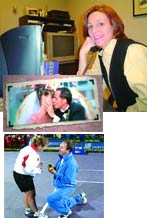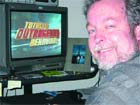Wexler Video provides a post set-up for NBC's Fear Factor.
Reality may not be as compelling, funny or outrageous as it appears to be in reality TV programming. So it's up to talented offline and online editors to use their skills to capture viewers' attention and keep them coming back episode after episode.
BANYAN: A HUB FOR REALITY IN PHILLY
Eleven original reality series, including the hit Trading Spaces franchise, are produced and posted by Philadelphia-based Banyan Productions (www.banyanprod.com), whose Virtual Production Services division is more than capable of handling the big volume of work - 530 episodes in 2003. It currently boasts 15 Avid Media Composers and several Xpress DVs, a LANshare system for media sharing with 3TB of storage, three Avid Symphony systems, two Digidesign Pro Tools DAWs and a staff to man them.

According to Linda Calabrese-Kane, Banyan has just installed an Avid|DS HD for conforming shows like A Wedding Story and Perfect Proposal.
|
"We do a lot of the daytime lineup of TLC and Discovery [including A Wedding Story, A Dating Story, A Makeover Story and Perfect Proposal], which are all shot in the field," says director of operations Linda Calabrese-Kane. "We tend to give them four or five days for the edit, a day to fix with client notes and then move to the mastering stage. The stories are all told a little differently but the logistics are very similar."
Banyan's Ambush Makeover, which is going national on Fox, has a different scenario, however. With the TLC and Discovery shows, the producers typically return from the field, media log the show themselves and work alongside the editor to cut episodes together. Because of the shooting pattern and tight turnaround time for Ambush Makeover, field producers send tapes back to Banyan where editors work solo with scripts media logged and written by the producers.
"We had to do 65 episodes for the network in a short period of time, and this was the way to keep it moving," Calabrese-Kane explains. The format of the show is also more dynamic: There can easily be 900 edit events in a half-hour episode.
During the creative process for Ambush Makeover with Fox on the West Coast, "what really saved our butts was streaming video back and forth via an FTP site," says Calabrese-Kane. "It's a wonderful tool, almost realtime. Now we're finding all clients are asking for it."
She reports that "start-ups are always the most challenging. Perfect Proposal on TLC is our newest. We have about 20 episodes in and have hit our stride. All of our editors work on all of the shows; it takes a cycle or two before you get humming and creative."

Actual Realities edits The Residents and Showtime's Freshman Diaries (pictured).
|
Banyan just installed an Avid|DS HD system for conforming shows. "The workflow will be still be a Media Composer edit followed by digitizing in HD and the conform," says chief engineer Karl Feltner.
"Trading Spaces is driving this room," Calabrese-Kane notes. "We got a recent order to deliver 30 episodes in HD." Episodes of the popular series and other shows are already being shot in HD and outsourced for an HD finish, she reveals. "We wanted to have HD post in-house anyway; it helped that we got the order from TLC."
Each network requires different deliverables. "For a lot of TLC and Discovery shows last year we were shooting Digital Betacam 16:9 and outputting 4:3 and 16:9 masters," Calabrese-Kane reports. "Last January we had a seminar for our producers and camera operators with Karl to answer questions about the 16:9 format and how to frame for it. It went a long way toward making things go smoothly."

Wexler: geared up for reality
|
DOCTORS AND FRESHMAN
The challenge faced by day-in-the-life reality programming is to build the story over time and sustain viewer interest. Documentary filmmaker R.J. Cutler's Actual Reality Pictures (310-202-1272) in Culver City, CA, has a particular expertise with this sub-genre, having produced the Emmy Award-winning American High, VH1's Military Diaries and The Real Roseanne Show.
The Residents, which airs on Discovery Health and TLC, follows new doctors in their year of residency at UCLA Medical Center. "They had hundreds of hours of footage so the story department had to figure out how to piece things together - slow days, busy days - to make the story work in 13 one-hour episodes," notes post production supervisor Eric Towler. "Obviously, not everything you see is a linear day."
Key to the storytelling is focusing on the individual residents "so you care about what happens to the characters," Towler notes. Each resident has a pool of digitized footage, which editors can tap out of sequence "to try to tell the human stories."

Matchframe Video onlines a variety of reality programming, including Rich Girls.
|
Offline editing is done at Actual Reality by four editors working on Avid Media Composers linked by Unity. After the network approves the cut, Towler takes the show to Burbank's Level 3 Post for the conform, titling and final effects on Avid Symphony by Derek Herr. Then Burbank's FilmLook applies its proprietary process to the DV footage and does tape-to-tape da Vinci color correction.
Audio post is performed on Digidesign Pro Tools at Santa Monica's Oracle Post by mixer Earl Martin.
Another new series, The Freshman Diaries, which aired on Showtime, traced a dozen students during their first year at the University of Texas at Austin. While Actual Reality's post process for the show was similar to The Residents, the content was quite different. "The kids shot their own video diaries," Towler explains. "Professional camera crews followed them to certain events but the stories are largely composed of sound bites and footage from their video diaries.
"A bit of the diary footage is out of focus, some of the audio is a little too low or too hot but the footage is so important we couldn't not use it," he stresses. "It's part of the reality. We want to see it, imperfections and all. Very little color correction was done to the footage apart from skin tones." Level 3 Post's Derek Herr handled the Symphony finish with FilmLook again applying its magic. Troy Smith mixed on Fairlight at LA'sThe Post Group.
"The processes we've developed for these shows seem to work very well," notes Towler. "We're able to make adjustments as the technology changes."

Rick Frazier cuts a number of shows for Nash Entertainment, including Totally Outrageous Behavior. He uses an Avid Media Composer.
|
REAL HISTORY
Highly-experienced talent, client support and technical flexibility make Burbank's Matchframe Video (www.matchframe video.com) the choice of a wide array of reality programming producers. The company was the flagship facility for Lifestyles of the Rich and Famous, which GM Michael Levy reminds us was "one of the archetypes of this genre." In the '80s Matchframe Video was also one of the first in LA to provide reality TV producers with portable editing systems for their production offices.
The company has posted Road Rules for many years and counts among current clients The Osbournes, Rich Girls, The Mole, Sorority Life, Fraternity Life, Tough Enough, The Simple Life, Bug Juice,Totally Circus, Making the Band and Junkyard Wars.
Clients typically afford themselves of Matchframe Video's offline, online finishing, color correction and mixing capabilities.
For many shows, "'reality,' is a lot more planned and storyboarded than a matter of turning the cameras on and seeing what happens," he notes. "Because of the huge amount of source material - 50 to 60 or more sources per episode - and shooting conditions that are often less than ideal, one of the things online editor Malcolm Cook is responsible for is pulling everything together and creating the best possible product he can in the online bay," Levy explains.
"Sources are often mislabeled or have timecode problems, which have to be resolved by comparing to the offline 'chase' tape and consulting with the offline editor," says Cook. "Effects, such as compositing interviews with greenscreen backgrounds or the blurring of people's faces, body parts or product names, usually have to be handled in online because these effects cannot be perfected until you see them at full resolution."
Matchframe Video boasts four Avid Symphony systems on Unity shared storage and handles video formats from Hi-8 to Sony IMX. "Road Rules and other shows have moved to the IMX format," notes VP of sales Larry Mazzeo.
Most shows require intensive tape-to-tape color correction by colorist Mickey Rodriguez. "This is guerrilla-type shooting. Conditions are constantly changing. Cameras in the field are generally in the auto mode as people go in and out of buildings; sunlight and color levels are changing and we have to compensate for that," he explains.
Rodriguez also uses the da Vinci 8:8:8 with DUI to give color or hi-con treatments to flashback or memory sequences that help tell a story.
Unlike many facilities, Matchframe Video also provides full audio post for its reality TV clients. Mixer John Pooley often prelays, sweetens and performs the mix in one of the company's four audio rooms using a 32-channel Pro Tools|HD system.
Pooley says many shows have evolved from run-and-gun style audio to using "lots of good RF lavs" although stunts and outdoor shows like Surf Girls can't be miked.
For Road Rules eight or nine lavs from the kids and hosts are fed into a mixing board with the production mixer deciding who needs to be heard. "He may focus on the wrong conversation, so I need to bring out the person we want to hear," Pooley explains. "There's almost always a boom mic and camera mics, so I can try those sources. Or through mixing techniques I can bring up audio when that person is talking and take it down when they're not."
VH1's Born to Diva and Making the Band have had different audio challenges than the average reality show because of their musical performances. "They often recorded to [TASCAM] DA-88s or another multitrack format and we remix, or the band [is] remixed and sent me [as] finished tracks," Pooley notes.
Some shows are rife with profanity, which producers handle in different ways. "Some bleep it," says Pooley. "Others don't want to be distracted by a bleep so I drop it and fill it with ambiance. Others will bleep some of the profanity if it accentuates the story or drives the anger or comedy of the scene."
OUTRAGEOUS REALITY
At Hollywood's Nash Entertainment (323-468-4600), freelance editor Rick Frazier takes on the unique aspects of a clip-based reality TV show. He's working on Totally Outrageous Behavior, formerly called Stupid Behavior Caught On Tape, which resumes on Fox this month. Frazier previously cut Nash's Who Wants to Marry My Dad? and Meet My Folks, as well as portions of Temptation Island 2, the first Bachelor and Buena Vista Television's The Justice Hunters.
The content of Totally Outrageous Behavior consists of home video clips and elements collected worldwide. Once the producers ascertain their veracity, writers script episodes, which stitch together clips and host wraps featuring a studio audience.
Editors Mike Yanovich, Tim Preston, Jimmy Giritlian and Robbie Paramor cut the clips on Avid Media Composers linked with Unity. "Reality has to be tweaked and played with to make it work," notes Frazier. "They'll do slow-downs, speed-ups, push-ins and play with music to make the clips more interesting. If something just plays out straight it's boring." But the editors are careful to maintain the integrity of the clips' gags and whacky scenarios.
Sources, which come in on all formats, including Hi-8 and VHS, are typically bumped to Beta SP for the offline. Frazier polishes the edited clips, opening things up or trimming bits to make them funnier. He builds an episode with 16 to 18 clips, and adds extra sound effects but keeps the show free of laugh tracks. "All the editors here have creative responsibilities as well as a great collaboration with the producers," Frazier says.
With clips, "you are always crunched on time," he reports. "You get screener [tapes] from different sources and have to purchase the master, which may arrive the day before you online. We may get a master that doesn't contain the scene in the VHS screener and have to make a mad rush to ask for more footage or recut and reconfigure the story. We have flow charts and big boards with index cards that track all the temp and master footage."
Frazier is amazed by the subjective nature of comedy. When he screens an episode for the producers he'll find half the group laughing at any given clip and the other half not. He'll try to recut the clips until he can get the best response from everyone.
Frazier consolidates the Avid Symphony online, da Vinci color correction and audio post under Post Logic's roof.